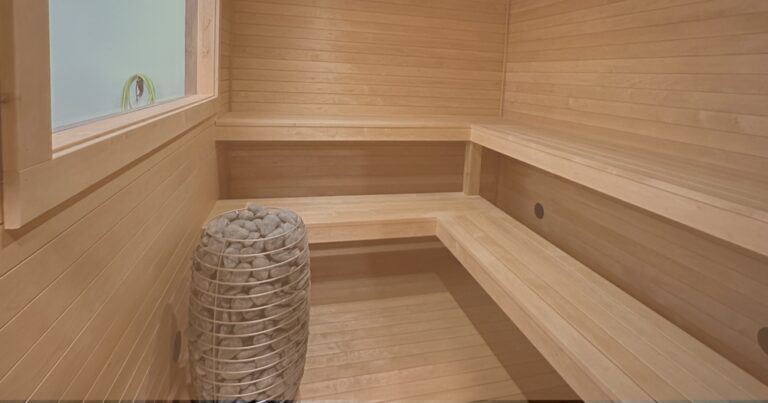It’s the ultimate sauna showdown! As sauna aficionados, we often hear one question: “Which is better, a traditional or an infrared sauna?”. Now, let’s be honest—there’s no such thing as an unbiased comparison. We all have our favorites but we’ll do our best to drill down on the differences that could make either choice the right sauna for your space and lifestyle. This guide aims to unravel the differences of each sauna and helping you make an informed decision.
The Basics: What Are Traditional and Infrared Saunas?
Traditional saunas, sometimes referred to as Finnish saunas, have been part of various cultures for thousands of years. They operate by heating a stack of rocks, either by wood or an electric heater, which then radiate heat into the room. These saunas are famed for their dry, intense heat that can soar to between 150 to 190 degrees Fahrenheit.
In contrast, infrared saunas are the new kids on the wellness block, first appearing in the 1960s. Rather than heating the air around you, infrared saunas use infrared panels to emit light that penetrates your skin, directly warming your body. This leads to a less intense heat—typically between 120 to 150 degrees Fahrenheit.
Understanding Sauna Heat: Traditional vs Infrared
The primary difference lies in how you experience the heat. Traditional saunas heat the air, which then heats your body. A well-designed traditional sauna will envelop you in a dense, even intense level of heat. On the other hand, infrared saunas warm you directly, leading to a different sensation—it’s a gentle, radiant heat that can penetrate deeper into your tissues. It’s like comparing the dry, encompassing heat of a desert to the warmth of direct sunlight on your skin.

Sweating It Out: Detoxification in Traditional vs Infrared Saunas
Both sauna types promote sweating, which is key for detoxification. However, infrared saunas may edge out the traditional ones in this department. According to some studies, the sweat from infrared sauna users can contain up to 20% toxins, compared to 3-5% toxins from traditional sauna sweat. But remember, sweating isn’t the only means of detoxification—your body also eliminates toxins through your internal organs.
Health Implications: Cardiovascular and Neurocognitive Effects
When it comes to health benefits, both sauna types are champions. Regular sauna usage has been linked to better cardiovascular health, improved circulation, and enhanced cognitive function. But, the heat difference does come into play here. The intense heat of traditional saunas provides a robust cardiovascular workout, making your heart pump faster. Infrared saunas, with their gentler heat, still offer cardiovascular benefits but may also enhance relaxation and stress reduction more effectively.
Weight Loss and Skin Health: Evaluating the Claims
As much as we’d all love a weight-loss miracle, saunas aren’t a magic bullet. While there’s some data to suggest they boost metabolism, what most people experience in the short-term is temporary water weight loss. Saunas won’t replace a healthy diet or regular exercise. That said, both sauna types can enhance your overall wellness routine by promoting relaxation and recovery. As for skin health, both sauna types can help clear pores and improve circulation, giving your skin a healthy glow.
Price, Installation, and Maintenance
In general, traditional saunas tend to be more expensive and need a more complicated installation. Most custom saunas in the States require a 30-amp electrical hookup and a well-designed ventilation system for safe use. Infrared saunas, in contrast, an affordable plug-and-play option for many homeowners. Maintenance for both types of saunas is relatively straightforward, with a focus on regular cleaning and occasional maintenance.

Materials, Durability, and Lifespan
Traditional saunas are built to last, often utilizing premium heat-modified materials, steel roofs, exterior windows, and LP smart siding, making them particularly well-suited for outdoor settings. These saunas are engineered to withstand the rigors of heavy wind, snow, and rain across all four seasons. In contrast, infrared saunas are generally crafted from high-quality woods like cedar or hemlock but may not offer the same level of resilience for outdoor use. The lifespan of your sauna will not only depend on its construction quality but also on your care routine. With proper maintenance, a traditional sauna can serve you for an extended period, often outlasting its infrared counterparts.
|
Traditional Vs Infrared Sauna Comparison
|
Making Your Choice: Factors to Consider When Choosing Between a Traditional and Infrared Sauna
Choosing between a traditional and an infrared sauna is a personal decision. It comes down to what you want out of your sauna experience. If you crave intense heat and a traditional ambiance, a traditional Finnish sauna might be for you. If you prefer a gentler heat and want a more energy-efficient option, an infrared sauna could be your pick.
Conclusion
Whether you’re a seasoned sauna user or a curious newcomer, understanding the differences between traditional and infrared saunas can guide you toward the right choice for your wellness journey. Whatever you choose, rest assured that both options offer significant health benefits and can add a fantastic touch to your active and adventurous lifestyle.




